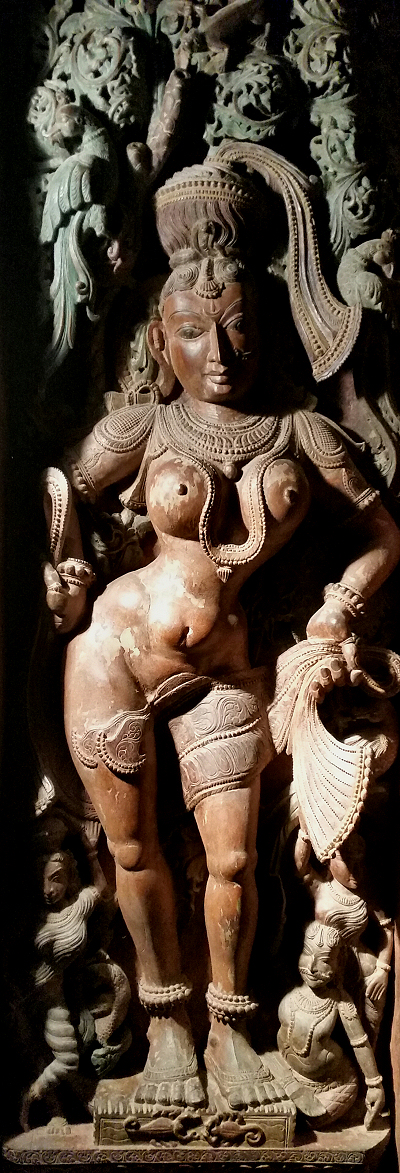APSARA or DEVATA
India, Tamil Nadu
18/19th century
Wood, faded polychrome painting.
Height 186 cm
Heavenly damsel, celestial dancer. Southern India, probably Tamil Nadu; possibly from the village of Thammampatti. Due to dearth of cognates hard to date. Presumed to be late 18th or 19th C. Apsaras, in Hindu mythology, are female spirits of the clouds and waters. In the Rig-Veda there is one Apsara, wife of Gandharva; in the later scriptures there are many Apsaras who act as the handmaidens of Indra and dance before his throne. They are able to change their form, and specially rule over the fortunes of gaming. One of their duties is to guide to paradise the heroes who fall in battle, whose wives they then become. They are distinguished as daivika ("divine") or laukika (" worldly").
Apsaras are supernatural beings: they appear as young women of great beauty and elegance who are proficient in the art of dancing. They are the wives of the Gandharvas, court servants of Indra. They dance to the music made by their husbands, usually in the palaces of the gods, and entertain gods and fallen heroes. In their assignment as caretakers of fallen heroes, they may be compared to the valkyries of Norse mythology. Apsaras are said to be able to change their shapes at will, and specially rule over the fortunes of gaming and gambling.
A story type or theme appearing over and over again in the Mahabharata is that of an Apsara sent to distract a sage or spiritual master from his ascetic practices. One story embodying this theme is that recounted by a woman named Sakuntala to explain her own parentage (Book I: Adi Parva, Section 71-72.) Once upon a time, the sage Viswamitra generated such intense energy by means of his asceticism that Indra himself became fearful. Deciding that the sage would have to be distracted from his penances, he sent the Apsara Menaka to work her charms. Menaka trembled at the thought of angering such a powerful ascetic, but she obeyed the god's order. As she approached Viswamitra, the wind god Marut tore away her garments. Seeing her thus disrobed, the sage abandoned himself to lust. Nymph and sage sported together for some time, during which Viswamitra's asceticism was put on hold. As a consequence, Menaka gave birth to a daughter, whom she abandoned at on the banks of a river. That daughter was Sakuntala herself, the narrator of the story.
Provenance: Private seller, Antwerp

|
 HOME
HOME
